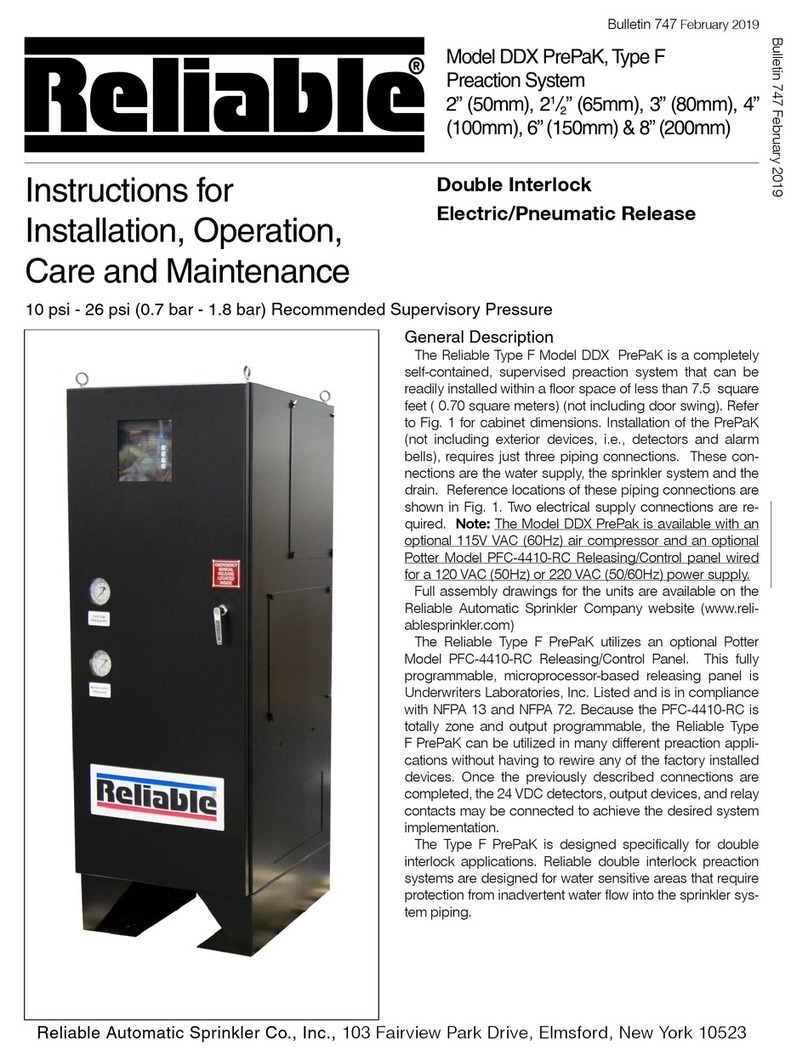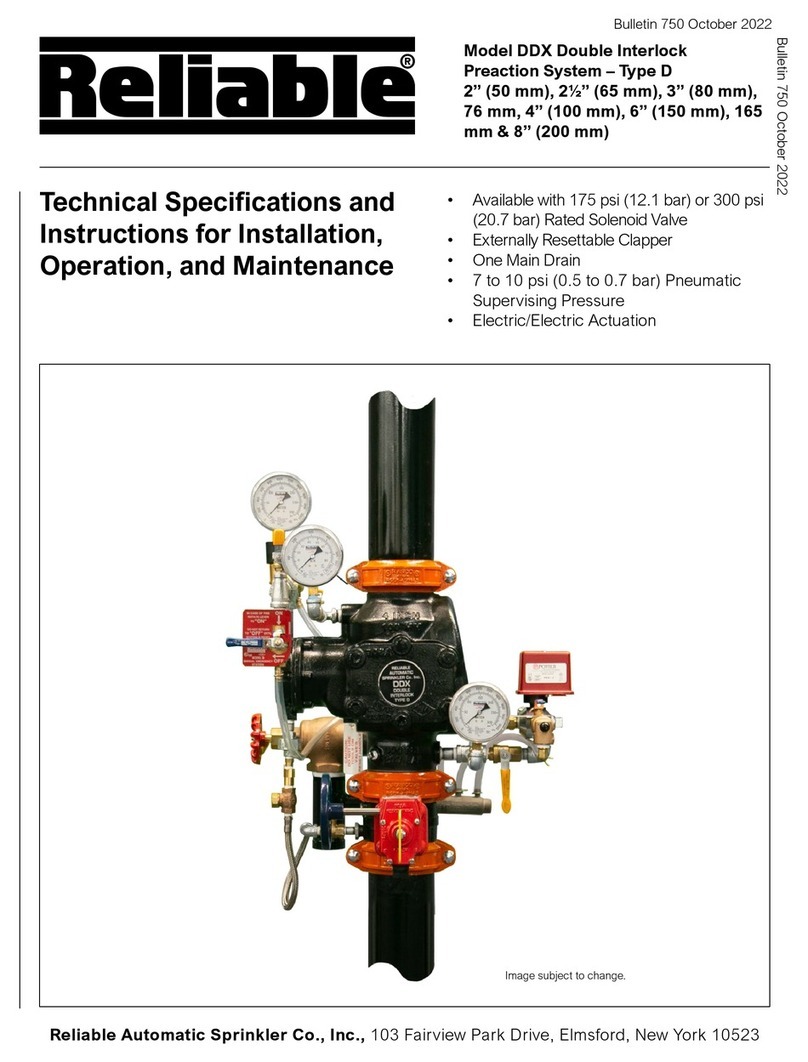
5.
System Operation (Single Interlock)
To fully activate and discharge water from the Reliable Mod-
el DDX Type D PrePaK in a single interlock application, a fire
detection device (smoke, heat, etc.; or two devices with cross-
zoned detection) must activate. Subsequently, a fire sprinkler
must open.
When the single interlock preaction system is set for service,
the supply pressure acts both on the underside of the deluge
valve’s clapper and on the valve’s push rod by means of the
pressurized push rod chamber. The pressure force acting on
the push rod, when utilized with the mechanical advantage of
the deluge valve’s lever, is more than sufficient to hold the clap-
per in the closed position against the water supply pressure.
Energizing the releasing solenoid the pushrod chamber sup-
ply valve allows the deluge valve push-rod chamber to be vent-
ed to drain. Since the pressure cannot be replenished through
the inlet restriction as rapidly as it is vented though the outlet,
the push-rod chamber pressure falls rapidly. When the push-rod
chamber pressure drops below one-third of the supply pres-
sure, the opening force acting beneath the clapper becomes
greater than the push-rod force acting on the lever. This causes
the clapper to open. Refer to Reliable Bulletin 519 for further de-
tails.
Once the clapper has opened, the lever acts as a latch, pre-
venting the clapper from returning to the closed position. Water
from the supply flows through the deluge valve into the system
piping. Water also flows through the deluge the pushrod cham-
ber supply valve alarm outlet to activate any water flow alarm
devices. Note that the solenoid valve will be maintained open by
the Potter Model PFC-4410-RC Releasing Control Panel’s latch-
ing feature until it is reset for operation.
After system shutdown and draining, the Model DDX Deluge
Valve is easily reset without special tools using the external re-
set feature. Restore detection devices by resetting or replacing
any operated device. Once detection devices are restored, (the
Potter Model PFC-4410-RC Releasing Control Panel reset), and
supply pressure is re-supplied to the push-rod chamber, the
deluge valve is reset.
System Operation (Double Interlock)
To fully activate and discharge water from the Reliable Model
DDX Type D PrePaK in a double interlock application, two inde-
pendent events must coexist. An electrical fire detection device
(smoke, heat, etc.) and the system air pressure switch must be
activated. This pressure switch is activated by a reduction of the
system pneumatic pressure as a result of sprinkler operation.
Both of these events will cause the control panel to energize the
solenoid valve, thereby releasing water through the deluge the
pushrod chamber supply valve and into the sprinkler system.
The initiation of either one of these events will only cause an
alarm to annunciate, and will not fill the sprinkler system.
When the double interlock preaction system is set for service,
the supply pressure acts both on the underside of the deluge
valve’s clapper and on the valve’s push rod by means of the
pressurized push rod chamber. The pressure force acting on
the push rod, when utilized with the mechanical advantage of
the deluge valve’s lever, is more than sufficient to hold the clap-
per in the closed position against the water supply pressure.
Energizing the releasing solenoid the pushrod chamber sup-
ply valve allows the deluge valve push-rod chamber to be vent-
ed to drain. Since the pressure cannot be replenished through
the inlet restriction as rapidly as it is vented though the outlet,
the push-rod chamber pressure falls rapidly. When the push-rod
chamber pressure drops below one-third of the supply pres-
sure, the opening force acting beneath the clapper becomes
greater than the push-rod force acting on the lever. This causes
the clapper to open. Refer to Reliable Bulletin 519 for further de-
tails.
Once the clapper has opened, the lever acts as a latch, pre-
venting the clapper from returning to the closed position. Water
from the supply flows through the deluge valve into the system
piping. Water also flows through the deluge the pushrod cham-
ber supply valve alarm outlet to activate any water flow alarm
devices. Note that the solenoid valve will be maintained open by
the Potter Model PFC-4410-RC Releasing Control Panel’s latch-
ing feature until it is reset for operation.
After system shutdown and draining, the Model DDX Deluge
Valve is easily reset without special tools using the external re-
set feature. Restore detection devices by resetting or replacing
any operated device. Once detection devices are restored, (the
Potter Model PFC-4410-RC Releasing Control Panel reset), and
supply pressure is re-supplied to the push-rod chamber, the
deluge valve is reset.
Resetting Single And Double Interlock Systems
1. Close the main valve controlling water supply to the deluge
the pushrod chamber supply valve and close the ¼” air
shutoff valve.
2. Close the pushrod chamber supply valve.
3. Open the main drain the pushrod chamber supply valve
and drain system.
4. Open all drain valves and vents at low points throughout
the system, closing them when flow of water has stopped.
Open the Manual Emergency Release Valve. Note: The
above steps accomplish the relieving of pressure in the
pushrod chamber of the deluge valve.
5. Push in the plunger of ball drip valve to force the ball from its
seat, and drain any water in the alarm line.
6. With the Model B Manual Emergency Station open, push
in and rotate the deluge the alarm test valve external re-
set knob counterclockwise (when facing valve) until you
hear a distinct clicking noise, indicating that the clapper
has closed. Note: The reset knob can be rotated only after
pressure in the pushrod chamber is reduced to atmospher-
ic conditions (0 psig).
7. Inspect and replace any portion of the sprinkler system
subjected to fire conditions.
8. Verify that the following valves are in their respective posi-
tions:
Manual Emergency Release - open
Main Drain Valve - open
Alarm Line Valve - open
Alarm Test Valve - closed
Condensate Drain valve - closed
Air Supply Valves - closed
9. Open the pushrod chamber supply the pushrod chamber
supply valve and allow water to fill the deluge valve push-
rod chamber. Close the Manual Emergency Release valve.






























